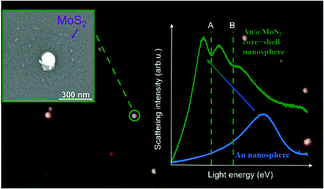Single-particle spectroscopic investigation on the scattering spectrum of Au@MoS2 core–shell nanosphere heterostructure†
Abstract
Owing to the uniform shape of the nanospheres, the Au@MoS2 core–shell nanosphere heterostructure enables us to design nano-optoelectronic devices and nanosensors with highly tunable and reproducible optical properties. However, until now, at the single-particle level, there is still uncertainty as to how much the scattering characteristics depend on the particle size and the local environment. In this letter, we performed an in situ single-particle study of the scattering spectrum of the Au@MoS2 core–shell nanosphere heterostructure before and after coating with the MoS2 layer. Single-particle characterization confirms that the classic quasi-static approximation (QSA) theory can be used to predict the scattering spectra of Au@MoS2 core–shell nanoparticles. Moreover, we have found that the A and B-exciton absorption peaks do not rely on the local refractive index change, while the position of the particle plasmon resonances does. Such features can be used as an internal reference for sensing applications against measurement errors, such as defocusing the imaging. Our results show that Au@MoS2 core–shell nanoparticles have the potential to become one of the promising nanosensors in the field of single-particle sensing.



 Please wait while we load your content...
Please wait while we load your content...